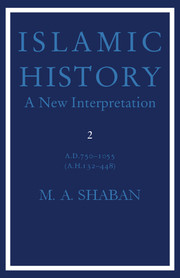Book contents
- Frontmatter
- Contents
- Acknowledgements
- Preface
- 1 The founding of the ʿAbbāsid regime
- 2 Towards a civil war
- 3 Dissolution under a new regime
- 4 The origins of the iqṭāʿ
- 5 Regional economic conflicts
- 6 The breakdown of the central government (I)
- 7 The breakdown of the central government (II)
- 8 The Būyid confederacy
- 9 The Fātimids
- Works cited
- Index
7 - The breakdown of the central government (II)
Published online by Cambridge University Press: 05 June 2012
- Frontmatter
- Contents
- Acknowledgements
- Preface
- 1 The founding of the ʿAbbāsid regime
- 2 Towards a civil war
- 3 Dissolution under a new regime
- 4 The origins of the iqṭāʿ
- 5 Regional economic conflicts
- 6 The breakdown of the central government (I)
- 7 The breakdown of the central government (II)
- 8 The Būyid confederacy
- 9 The Fātimids
- Works cited
- Index
Summary
The anxiety of the wazīr, ʿAbbās, before the death of Muktafī had not been without good reason; he had known, for some time, that there would be a crisis of succession. Muktafī, who died at the age of thirty-two, had been in failing health for several months, if not longer. As his children were too young, he had expressed the wish that he should be succeeded by his brother, Jaʿfar, who had just reached puberty. Having been in office for four years, the experienced wazīr was convinced that the absence of strong leadership would simply take the lid off the whole situation. There were three separate military forces; one in the provinces and two in Baghdād. The former, which constituted the third division, was dispersed in various regions and was not a cause for compelling worry. But the other two, the elite force of the first division and the police force of the second division, were concentrated in the capital. From the time of their formation they had been under the direct command of strong rulers who had used them effectively as instruments of the central government. A boy of thirteen could not be expected to take personal charge of these vital forces; that would leave their commanders in virtual mastery of the government. The fact that one of these commanders was the maternal uncle of the boy ruler could only add to the apprehensions of the wazīr.
- Type
- Chapter
- Information
- Islamic HistoryA New Interpretation, pp. 137 - 158Publisher: Cambridge University PressPrint publication year: 1976



